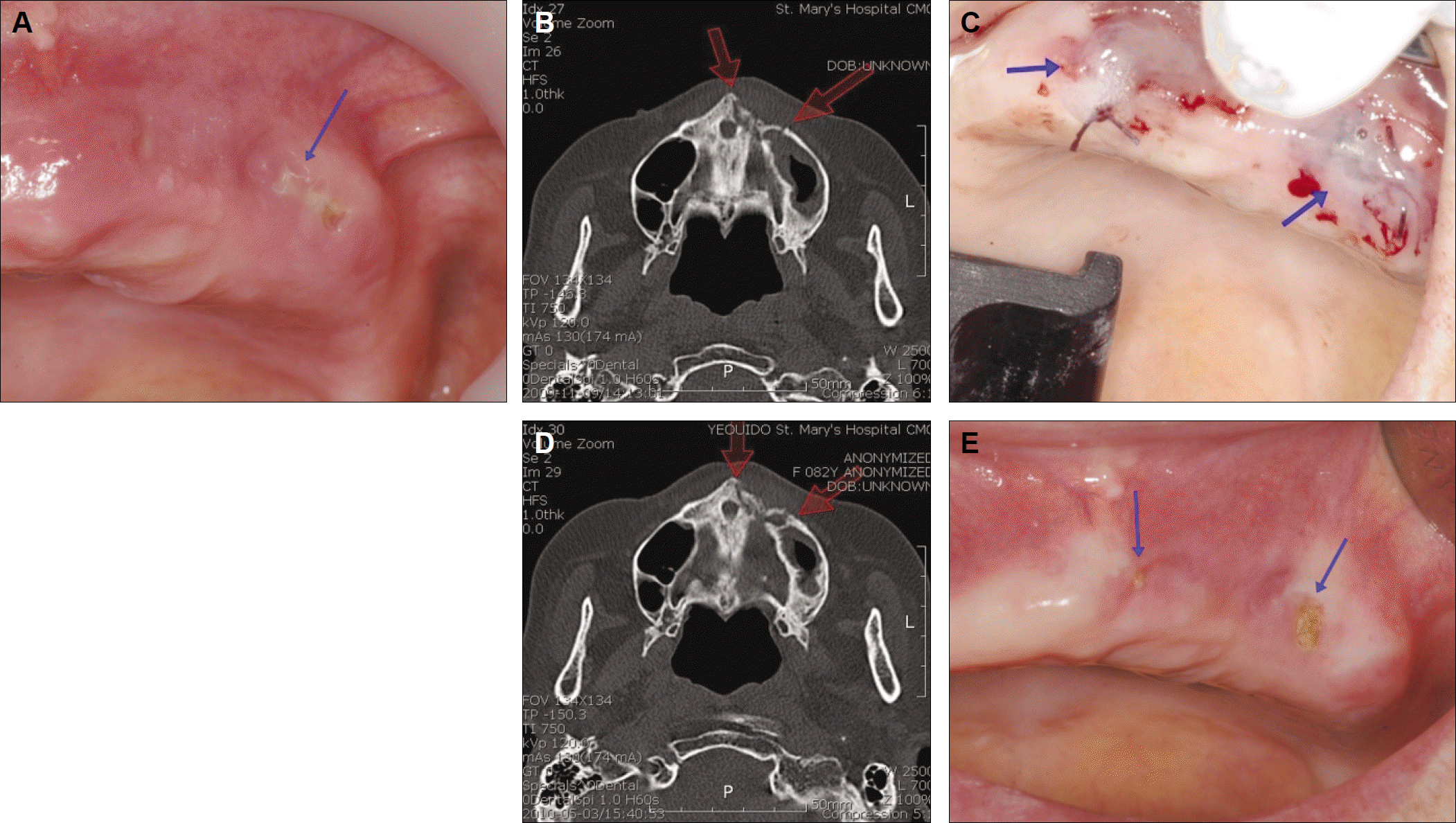Abstract
Bisphosphonates are used effectively for many medical conditions, such as multiple myeloma, Paget’ s disease, osteoporosis, etc. However, recently, osteonecrosis of the jaw was observed in patients receiving longterm bisphosphonate therapy, including oral administration. This osteonecrosis is refractory, and complete recovery is not guaranteed despite a standard treatment protocol being established by many associations related to oral and maxillofacial surgery. The treatment outcome of oral bisphosphonate-related osteonecrosis of jaw (BRONJ) is reported with a review of the relevant literature.
Go to : 
REFERENCES
1. Ashcroft AJ, Davies FE, Morgan GJ. Aetiology of bone disease and the role of bisphosphonates in multiple myeloma. Lancet Oncol. 2003; 4:284–92.

2. Delmas PD, Meunier PJ. The management of Paget’ s disease of bone. N Engl J Med. 1997; 336:558–66.
3. Hillner BE, Ingle JN, Chlebowski RT, Gralow J, Yee GC, Janjan NA, et al. American Society of Clinical Oncology. American Society of Clinical Oncology 2003 update on the role of bisphosphonates and bone health issues in women with breast cancer. J Clin Oncol. 2003; 21:4042–57.
4. Olson KB, Hellie CM, Pienta KJ. Osteonecrosis of jaw in patient with hormone-refractory prostate cancer treated with zoledronic acid. Urology. 2005; 66:658.

5. Rosen LS, Gordon D, Tchekmedyian NS, Yanagihara R, Hirsh V, Krzakowski M, et al. Long-term efficacy and safety of zoledronic acid in the treatment of skeletal metastases in patients with nonsmall cell lung carcinoma and other solid tumors: a randomized, Phase III, double-blind, placebo-controlled trial. Cancer. 2004; 100:2613–21.
6. Boonyapakorn T, Schirmer I, Reichart PA, Sturm I, Massenkeil G. Bisphosphonate-induced osteonecrosis of the jaws: prospective study of 80 patients with multiple myeloma and other malignancies. Oral Oncol. 2008; 44:857–69.

8. Letocha AD, Cintas HL, Troendle JF, Reynolds JC, Cann CE, Chernoff EJ, et al. Controlled trial of pamidronate in children with types III and IV osteogenesis imperfecta confirms vertebral gains but not short-term functional improvement. J Bone Miner Res. 2005; 20:977–86.

9. Ruggiero SL, Dodson TB, Assael LA, Landesberg R, Marx RE, Mehrotra B. American Association of Oral and Maxillofacial Surgeons. American Association of Oral and Maxillofacial Surgeons position paper on bisphosphonate-related osteonecrosis of the jaws-2009 Update. J Oral Maxillofac Surg. 2009; 67(5 Suppl):2–12.

10. Carlson ER, Basile JD. The role of surgical resection in the management of bisphosphonate-belated osteonecrosis of the jaws. J Oral Maxillofac Surg. 2009; 67(5 Suppl):85–95.
11. Williamson RA. Surgical management of bisphosphonate induced osteonecrosis of the jaws. Int J Oral Maxillofac Surg. 2010; 39:251–5.

12. Marx RE. Pamidronate (Aredia) and zoledronate (Zometa) induced avascular necrosis of the jaws: a growing epidemic. J Oral Maxillofac Surg. 2003; 61:1115–7.

13. Ruggiero SL, Mehrotra B, Rosenberg TJ, Engroff SL. Osteonecrosis of the jaws associated with the use of bisphosphonates: a review of 63 cases. J Oral Maxillofac Surg. 2004; 62:527–34.

14. Ruggiero SL, Fantasia J, Carlson E. Bisphosphonate-related osteonecrosis of the jaw: background and guidelines for diagnosis, staging and management. Oral Surg Oral Med Oral Pathol Oral Radiol Endod. 2006; 102:433–41.

15. Marx RE, Sawatari Y, Fortin M, Broumand V. Bisphosphonate-induced exposed bone (osteonecrosis/osteopetrosis) of the jaws: risk factors, recognition, prevention, and treatment. J Oral Maxillofac Surg. 2005; 63:1567–75.

16. Woo SB, Hellstein JW, Kalmar JR. Narrative [corrected] review: bisphosphonates and osteonecrosis of the jaws. Ann Intern Med. 2006; 144:753–61.
17. Chaudhry AN, Ruggiero SL. Osteonecrosis and bisphosphonates in oral and maxillofacial surgery. Oral Maxillofac Surg Clin North Am. 2007; 19:199–206. vi.

18. Badros A, Weikel D, Salama A, Goloubeva O, Schneider A, Rapoport A, et al. Osteonecrosis of the jaw in multiple myeloma patients: clinical features and risk factors. J Clin Oncol. 2006; 24:945–52.

19. Mavrokokki T, Cheng A, Stein B, Goss A. Nature and frequency of bisphosphonate-associated osteonecrosis of the jaws in Australia. J Oral Maxillofac Surg. 2007; 65:415–23.

20. Harper R, Fung E. Resolution of bisphosphonate-associated osteonecrosis of the mandible: possible application for intermittent low-dose parathyroid hormone [rhPTH (1-34)]. J Oral Maxillofac Surg. 2007; 65:573–80.
21. Adornato M, Morcos I, Rozanski J. The treatment of bisphosphonate-associated osteonecrosis of the jaws with bone resection and autologous platelet-derived growth factors. J Am Dent Assoc. 2007; 138:971–7.

22. Freiberger JJ. Utility of hyperbaric oxygen in treatment of bisphosphonate related osteonecrosis of the jaws. J Oral Maxillofac Surg. 2009; 67(5 Suppl):96–106.
Go to : 
 | Fig. 1.A. Case 1: Initial intraoral view. It was observed gingival swelling, pus discharged.(blue arrow) B. Case 1: Initial CT scan, transverse view. Focal osteolytic lesion at the right upper alveolar process with marked soft tissue swelling. (red arrow) C. Case 1: Thirteen months later intraoral view. Bone exposure was detected.(blue arrow) The other symptom was subside. (CT: computed tomography) |
 | Fig. 2.A. Case 2: Initial intraoral view. Pus was discharged.(blue arrow) B. Case 2: Initial CT scan, transverse view. Osteolytic lesion at the left maxillary alveolar process.(red arrows) C. Case 2: Intraoperative view. Primary closure and tisseel application was done.(blue arrow) D. Case 2: Postoperation 5 months later CT scan, transverse view. Sequestrae are still observered E. Case 2: Postoperation 5 months later intraoral view. Bone exposure was persisted, but the other symptom was subside.(blue arrow) (CT: computed tomography) |
 | Fig. 3.A. Case 3: Initial intraoral view. Bone was detected.(blue arrow) Patient had painful sensation. B. Case 3: Bone fragment was extracted during wound irrigation. C. Case 3: Six months later intraoral view. Pain was subside, but bone exposure was remained.(blue arrow) |
Table 1.
Staging and treatment strategies of BRONJ by AAOMS position paper9
Table 2.
Etiologic factor, bisphosphonate therapy, treatment and stage changing of each cases: treatment plan was done in accordance with AAOMS position paper. Except in the case 1, conditions of case 2, 3 were improved




 PDF
PDF ePub
ePub Citation
Citation Print
Print


 XML Download
XML Download